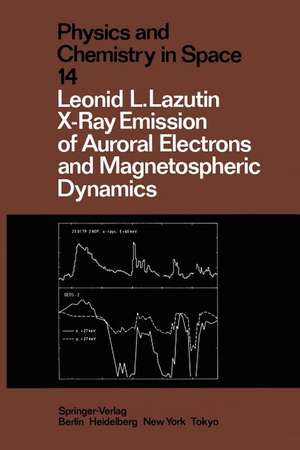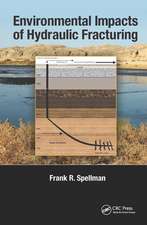X-Ray Emission of Auroral Electrons and Magnetospheric Dynamics: Physics and Chemistry in Space, cartea 14
Autor Leonid L. Lazutin Editat de Theodore J. Rosenbergen Limba Engleză Paperback – 6 dec 2011
Din seria Physics and Chemistry in Space
-
 Preț: 385.84 lei
Preț: 385.84 lei -
 Preț: 382.18 lei
Preț: 382.18 lei - 15%
 Preț: 643.84 lei
Preț: 643.84 lei -
 Preț: 383.50 lei
Preț: 383.50 lei - 18%
 Preț: 729.84 lei
Preț: 729.84 lei - 15%
 Preț: 642.83 lei
Preț: 642.83 lei -
 Preț: 385.08 lei
Preț: 385.08 lei -
 Preț: 381.98 lei
Preț: 381.98 lei -
 Preț: 381.43 lei
Preț: 381.43 lei - 15%
 Preț: 637.78 lei
Preț: 637.78 lei - 15%
 Preț: 634.49 lei
Preț: 634.49 lei -
 Preț: 388.34 lei
Preț: 388.34 lei -
 Preț: 392.21 lei
Preț: 392.21 lei - 15%
 Preț: 697.47 lei
Preț: 697.47 lei -
 Preț: 382.18 lei
Preț: 382.18 lei - 15%
 Preț: 643.84 lei
Preț: 643.84 lei - 15%
 Preț: 638.43 lei
Preț: 638.43 lei -
 Preț: 383.50 lei
Preț: 383.50 lei -
 Preț: 385.08 lei
Preț: 385.08 lei -
 Preț: 385.08 lei
Preț: 385.08 lei - 18%
 Preț: 778.32 lei
Preț: 778.32 lei - 18%
 Preț: 777.83 lei
Preț: 777.83 lei -
 Preț: 381.81 lei
Preț: 381.81 lei
Preț: 637.59 lei
Preț vechi: 750.11 lei
-15% Nou
Puncte Express: 956
Preț estimativ în valută:
122.04€ • 132.61$ • 102.58£
122.04€ • 132.61$ • 102.58£
Carte tipărită la comandă
Livrare economică 21 aprilie-05 mai
Preluare comenzi: 021 569.72.76
Specificații
ISBN-13: 9783642704000
ISBN-10: 364270400X
Pagini: 240
Ilustrații: XIV, 220 p.
Dimensiuni: 155 x 235 x 13 mm
Greutate: 0.34 kg
Ediția:Softcover reprint of the original 1st ed. 1986
Editura: Springer Berlin, Heidelberg
Colecția Springer
Seria Physics and Chemistry in Space
Locul publicării:Berlin, Heidelberg, Germany
ISBN-10: 364270400X
Pagini: 240
Ilustrații: XIV, 220 p.
Dimensiuni: 155 x 235 x 13 mm
Greutate: 0.34 kg
Ediția:Softcover reprint of the original 1st ed. 1986
Editura: Springer Berlin, Heidelberg
Colecția Springer
Seria Physics and Chemistry in Space
Locul publicării:Berlin, Heidelberg, Germany
Public țintă
ResearchCuprins
1 Balloon Experiment Technique.- 1.1 Launching Facilities.- 1.2 The Balloon in Space Research.- 1.3 Auroral X-Ray Scintillator Spectrometer.- 1.4 Payload Equipment.- 1.5 Ground-Based Support of Balloon Experiments.- 2 Auroral X-Rays: Generation and Transfer into the Atmosphere.- 2.1 Introduction.- 2.2 Photon Generation at the Atmospheric Boundary.- 2.3 Calculation of X-Ray Propagation in the Atmosphere.- 2.4 Transformation of X-Ray Flux and Energy Spectrum in the Atmosphere for Extended Regions of Precipitation.- 2.5 Results of Calculation of Photon Transport from Local Sources.- 2.6 X-Ray Angular Distribution.- 2.7 Calculation of Scintillator Spectrometer Efficiency.- 2.8 Practical Example of Electron Spectra Reconstruction.- 2.9 Conclusions and Recommendations.- 3 The Structure of Auroral X-Ray Events and Electron Fluxes in the Magnetosphere.- 3.1 General Features of X-Ray Events.- 3.2 Classification of Auroral X-Ray Forms.- 3.3 Charged Particles in the Magnetosphere.- 3.4 Auroral Radiation.- 4 Auroral Electrons in the Midnight Sector and Magnetospheric Disturbances.- 4.1 Dynamic and Energetic Structure of the Magnetospheric Substorm.- 4.2 Growth Phase.- 4.3 Breakup — An Explosive Onset in the Active Phase of a Substorm.- 4.4 Active Phase. Convection.- 4.5 Active Phase. Expansion.- 4.6 Auroral Region Model of Electron Acceleration and Precipitation During Substorms.- 5 Pulsations and Microbursts of Drifting Auroral Electron Precipitation.- 5.1 Morning Bay-Like Precipitations.- 5.2 Long-Period X-Ray Pulsations (1–20 min).- 5.3 Fast Pulsations and Impulses (3–60 s).- 5.4 Auroral X-Ray Microbursts.- 5.5 Precipitations During SC and SI.- 5.6 Interrelation of Pulsating Structures of Precipitating Auroral Electrons.- 5.7 Classification of the Microstructure ofElectron Precipitation.- Conclusion.- References.- Subjectlndex.

















